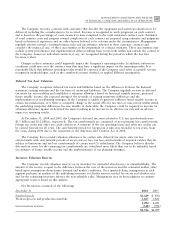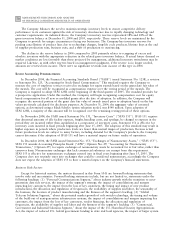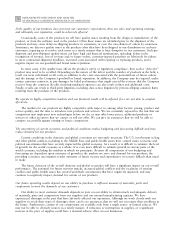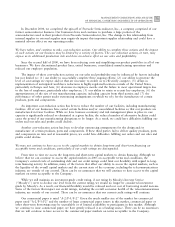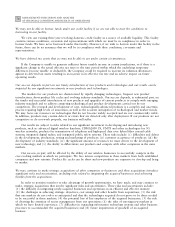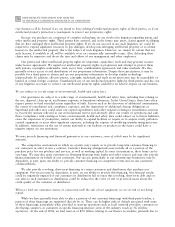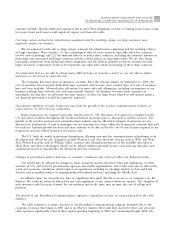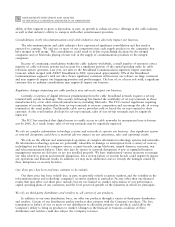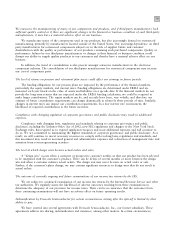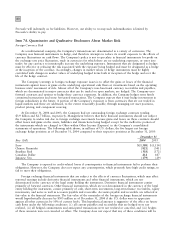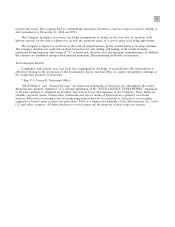Motorola 2004 Annual Report Download - page 84
Download and view the complete annual report
Please find page 84 of the 2004 Motorola annual report below. You can navigate through the pages in the report by either clicking on the pages listed below, or by using the keyword search tool below to find specific information within the annual report.
76 MANAGEMENT'S DISCUSSION AND ANALYSIS
OF FINANCIAL CONDITION AND RESULTS OF OPERATIONS
Our business will be harmed if we are found to have infringed intellectual property rights of third parties, or if our
intellectual property protection is inadequate to protect our proprietary rights.
Because our products are comprised of complex technology, we are involved in litigation regarding patent and
other intellectual property rights. Third parties have asserted, and in the future may assert, claims against us alleging
that we have infringed their intellectual property rights. If we do not succeed in any such litigation, we could be
required to expend signiÑcant resources to pay damages, develop non-infringing intellectual property or to obtain
licenses to the intellectual property that is the subject of such litigation. However, we cannot be certain that any
such licenses, if available at all, will be available to us on commercially reasonable terms. Also, defending these
claims may be expensive and divert the time and eÅorts of our management and other employees.
Our patent and other intellectual property rights are important competitive tools and may generate income
under license agreements. We regard our intellectual property rights as proprietary and attempt to protect them
with patents, copyrights, trademarks, trade secret laws, conÑdentiality agreements and other methods. We also
generally restrict access to and distribution of our proprietary information. Despite these precautions, it may be
possible for a third party to obtain and use our proprietary information or develop similar technology
independently. In addition, eÅective patent, copyright, trademark and trade secret protection may be unavailable or
limited in certain foreign countries. Unauthorized use of our intellectual property rights by third parties and the cost
of any litigation necessary to enforce our intellectual property rights could have an adverse impact on our business.
We are subject to a wide range of environmental, health and safety laws.
Our operations are subject to a wide range of environmental, health and safety laws, including laws relating to
the use, disposal, clean up of, and human exposure to hazardous substances. In the United States, these laws often
require parties to fund remedial action regardless of fault. Factors such as the discovery of additional contaminants,
the extent of remediation and compliance expenses, and the imposition of additional cleanup obligations at
Superfund and other sites could cause our capital expenditures and other expenses relating to remediation activities
to exceed the amount reÖected in our environmental reserve and adversely aÅect our results of operations and cash
Öows. Compliance with existing or future environmental, health and safety laws could subject us to future liabilities,
cause the suspension of production, restrict our ability to expand facilities or require us to acquire costly pollution
control equipment or incur other signiÑcant expenses, including the expense of modifying manufacturing processes.
In addition, restrictions on the use of certain materials in our facilities or products in the future could have a
negative impact on our operations.
We may provide Ñnancing and Ñnancial guarantees to our customers, some of which may be for signiÑcant
amounts.
The competitive environment in which we operate may require us to provide long-term customer Ñnancing to
our customers in order to win a contract. Customer Ñnancing arrangements may include all or a portion of the
purchase price for our products and services, as well as working capital. In some circumstances, these loans can be
very large. We may also assist customers in obtaining Ñnancing from banks and other sources and may also provide
Ñnancial guarantees on behalf of our customers. Our success, particularly in our infrastructure businesses, may be
dependent, in part, upon our ability to provide customer Ñnancing on competitive terms and on our customers'
creditworthiness.
We also provide revolving, short-term Ñnancing to certain customers and distributors that purchase our
equipment. Our success may be dependent, in part, on our ability to provide this Ñnancing. Our Ñnancial results
could be negatively impacted if our customers or distributors fail to repay this revolving, short-term debt and/or
our sales to such customers or distributors could be reduced in the event of real or perceived issues about the
credit quality of the customer or distributor.
When we lend our customers money in connection with the sale of our equipment, we are at risk of not being
repaid.
While we have generally been able to place a portion of our customer Ñnancings with third-party lenders, a
portion of these Ñnancings are supported directly by us. There can be higher risks of default associated with some
of these Ñnancings, particularly when provided to start-up operations such as local network providers, customers in
developing countries, or customers in speciÑc Ñnancing-intensive areas of the industry (such as 3G wireless
operators). At the end of 2004, we had reserves of $2.0 billion relating to our Ñnance receivables, primarily due to





